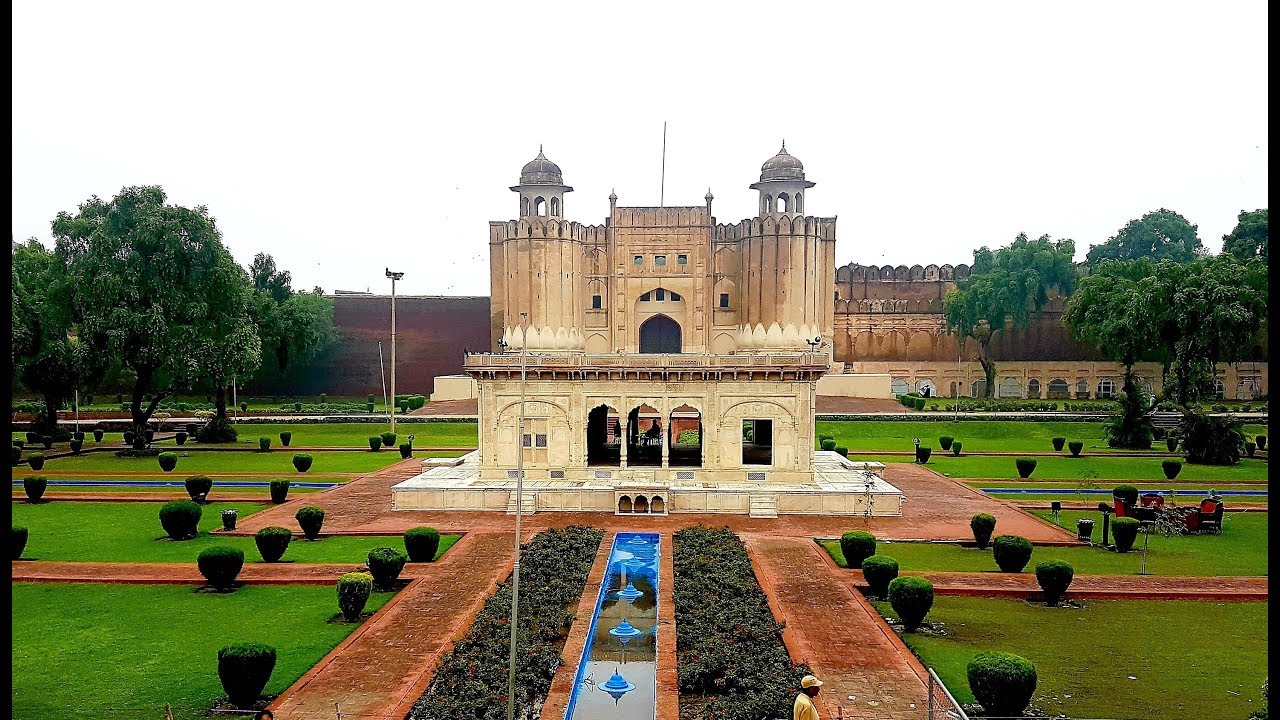The Lahore Fort also known as Shahi Qila is a citadel in the city of Lahore, Pakistan. The earliest reference to the fort comes in a history of Lahur (Lahore) compiled by Al-Biruni, which refers to a fort constructed in the early 11th century. He further notes that Munshi Sujan Rae Bhandari, author of the Khulasatut Tawarikh in 1695-96. He write in it that Malik Ayaz, a favorite of Sultan Mahmud, built a masonry fort at Lahore and repopulated the city. Khan believes it is the same fort that was demolish by the Mongols in 1241 and in 1398 by a detachment of Timur’s army. After which it was reconstruct again in 1421 by Sayyid, son of Khizr Khan.
The fortress is located at the northern end of walled city Lahore, and spreads over an area greater than 20 hectares. It contains 21 notable monuments, some of which date to the era of Emperor Akbar. The Lahore Fort is notable for having been almost entirely reconstruct in the 17th century. When the Mughal Empire was at the height of its splendour and opulence.
Construction and Architecture :
In the 16th century, Lahore became Akbar’s capital. In 1580 he established the Lahore Fort as it is known today. Since his reign, successive leaders have made their mark on the fort including Shah Jahan’s 17th century Crystal Palace or “Shish Mahal”. However, despite all of the renovations and additions to the Lahore Fort. Akbar’s work can generally be distinguish as the red brick constructions.
Construction of Some Main Structures of Lahore Fort :
The Lahore Fort ( Shahi Qila ) was Built, damaged, demolished, rebuilt and restored several times. Before Emperor Akbar in 1566 give its current form. The Lahore Fort is the star attraction of the Old City. Note that the museums here may close an hour or so before sunset. In 1524, Lahore was capture by the troops of the Mughal Babur. The Mughal Empire was an immensely successful Muslim empire of Turkic-Mongol origin. Its rulers controlled the entire subcontinent of India from the 16th to the mid-19th century. The present-day form of the Lahore Fort dates from 1575, when the Mughal Emperor Akbar the Great occupied the fort, rebuilt with stone, to guard his empire’s northwest frontier.
Emperor Jahangir first mentions his alterations to the fort in 1612 when describing the Maktab Khana. Jahangir also added the Kala Burj pavilion, which features European-inspired angels on its vaulted ceiling. British visitors to the fort noted Christian iconography during the Jahangir period, with paintings of the Madonna and Jesus found in the fort complex.
Shah Jahan first ordered the construction of the Diwan-i-Aam in the style of a Chehel Sotoun with 40-pillar public audience hall. The Royal Kitchen, behind the main gate of the fort, was also construct during the reign of Shah Jahan.
Alamgiri Gate :
The entrance to the fort is the Alamgiri Gate was construct during the era of Aurangzeb in 1674 as a private entrance to the royal quarters. It was large enough to allow several elephants carrying members of the royal household to enter at one time. The small Moti Masjid (Pearl Mosque) was construct during era of Shah Jahan in 1644 for the private use of the ladies of the royal household and was restore to its original delicacy in 1904.
After the Mughal Empire fell in the 18th century. The Lahore Fort was ransacked and many of its buildings were damaged. However it has now been carefully restore for visitors to enjoy its original splendour.
Overview Lahore Fort :
Lahore Fort is a magnificent treasury of 21 notable monuments of the era of Mughal Emperor Akbar. Mughal rulers had built the whole structure in 17th during the boom of Mughal’s glory and opulence. In 2000, it was add as the Unesco Heritage Sites and received a generous donation for preservation and conservation. Lahore Fort has two main gates for entrance 1st is Akbari Gate and other is Alamgiri Gate. The Fort has many gardens inside, rendering serene and tranquil ambience while strolling around. The history of the sumptuous legacy is explicitly mention on the different boards erect near the Akbari gate.
Various Constructions During Diffrent eras of Mughal Dynasty :
In various eras of Mughal’s dynasty, notable structures were built in Lahore Fort along with lush gardens. The facades include Daulat Khana-e-khas-o-Am, Jharoka-e-Darshan, Akbari Gate, Maktab Khana, Kala Burj, Lal Burj, Mosque Maryam Zamani Begum. Moreover Diwani-e-Aam, Shah Burj, Sheesh Mahal, Naulakha Pavillion, white Moti Masjid, Alamgiri Gate, and Three-doored Pavillion.
The whole fort is divide into two sections, first administrative section, connected with entrance and includes gardens of Diwan-e-khas. But the second section is dedicate to royal residence and approachable from elephant gate. Sheesh, Mahal and small gardens are also present in this section.
The exterior walls of the 2nd section are furnished with blue Persian Kashi tiles, Mosaic art and calligraphy. The huge Picture Wall has been taken as the triumph of Lahore Fort and exquisitely decorated with the vibrant pattern of glazed tiles, faience mosaics and fresco. Stretching to northern and western walls of the city. The embellish wall is approximately 1450 feet long and contains 116 panels that interpret multiple subjects like elephant fights, angels, and polo games. In short, Lahore Fort is the majestic spectacle of Lahore that depicts glorious history and culture of Lahore’s Walled City and requires an extensive amount of time and endurance to explore and appreciate.
Timing and Activities at Lahore Fort :
Lahore Fort open for visitors from 8:30am to 5:00pm.
Activities at Lahore Fort Include :
- Visit Shalimar Gardens and Badshahi Masjid
- Explore the old alleys of Walled City, Lahore
- Enjoy food at nearby eateries


Comment (1)